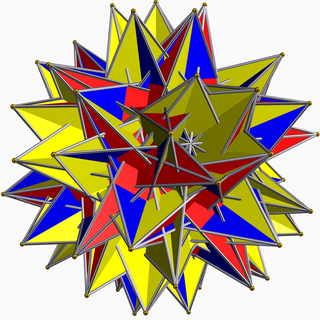| Great retrosnub icosidodecahedron | |
|---|---|

| |
| Type | Uniform star polyhedron |
| Elements | F = 92, E = 150 V = 60 (χ = 2) |
| Faces by sides | (20+60){3}+12{5/2} |
| Coxeter diagram | |
| Wythoff symbol | | 2 3/2 5/3 |
| Symmetry group | I, [5,3]+, 532 |
| Index references | U74, C90, W117 |
| Dual polyhedron | Great pentagrammic hexecontahedron |
| Vertex figure |  (34.5/2)/2 |
| Bowers acronym | Girsid |

In geometry, the great retrosnub icosidodecahedron or great inverted retrosnub icosidodecahedron is a nonconvex uniform polyhedron, indexed as U74. It has 92 faces (80 triangles and 12 pentagrams), 150 edges, and 60 vertices.[1] It is given a Schläfli symbol sr{3⁄2,5⁄3}.
YouTube Encyclopedic
-
1/2Views:2 3401 516
-
thicker icosidodecahedron
-
Icosidodecahedron
Transcription
Cartesian coordinates
Let be the smallest (most negative) zero of the polynomial , where is the golden ratio. Let the point be given by
- .
Let the matrix be given by
- .
is the rotation around the axis by an angle of , counterclockwise. Let the linear transformations be the transformations which send a point to the even permutations of with an even number of minus signs. The transformations constitute the group of rotational symmetries of a regular tetrahedron. The transformations , constitute the group of rotational symmetries of a regular icosahedron. Then the 60 points are the vertices of a great snub icosahedron. The edge length equals , the circumradius equals , and the midradius equals .
For a great snub icosidodecahedron whose edge length is 1, the circumradius is
Its midradius is
The four positive real roots of the sextic in R2, are the circumradii of the snub dodecahedron (U29), great snub icosidodecahedron (U57), great inverted snub icosidodecahedron (U69), and great retrosnub icosidodecahedron (U74).
See also
References
- ^ Maeder, Roman. "74: great retrosnub icosidodecahedron". MathConsult.
External links























